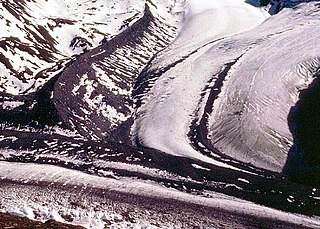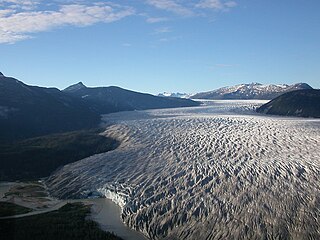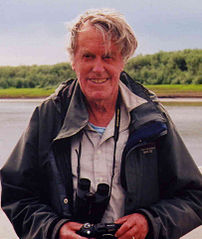Related Research Articles

Glaciology is the scientific study of glaciers, or more generally ice and natural phenomena that involve ice.

Axel Heiberg Island is an uninhabited island in the Qikiqtaaluk Region, Nunavut, Canada. Located in the Arctic Ocean, it is the 32nd largest island in the world and Canada's seventh largest island. According to Statistics Canada, it has an area of 43,178 km2 (16,671 sq mi). It is named after Axel Heiberg.

The National Snow and Ice Data Center (NSIDC) is a United States information and referral center in support of polar and cryospheric research. NSIDC archives and distributes digital and analog snow and ice data and also maintains information about snow cover, avalanches, glaciers, ice sheets, freshwater ice, sea ice, ground ice, permafrost, atmospheric ice, paleoglaciology, and ice cores.

Crucial to the survival of a glacier is its mass balance or surface mass balance (SMB), the difference between accumulation and ablation. Climate change may cause variations in both temperature and snowfall, causing changes in the surface mass balance. Changes in mass balance control a glacier's long-term behavior and are the most sensitive climate indicators on a glacier. From 1980 to 2012 the mean cumulative mass loss of glaciers reporting mass balance to the World Glacier Monitoring Service is −16 m. This includes 23 consecutive years of negative mass balances.

Edward Randle "Ed" LaChapelle was an American avalanche researcher, glaciologist, mountaineer, skier, author, and professor. He was a pioneer in the field of avalanche research and forecasting in North America.
Tavi Murray, is a glaciologist, the eighth woman to be awarded the Polar Medal.

The tidewater glacier cycle is the typically centuries-long behavior of tidewater glaciers that consists of recurring periods of advance alternating with rapid retreat and punctuated by periods of stability. During portions of its cycle, a tidewater glacier is relatively insensitive to climate change.

The Extreme Ice Survey (EIS), based in Boulder, Colorado, uses time-lapse photography, conventional photography and video to document the effects of global warming on glacial ice. It is the most wide-ranging glacier study ever conducted using ground-based, real-time photography. Starting in 2007 the EIS team installed as many as 43 time-lapse cameras at a time at 18 glaciers in Greenland, Iceland, Alaska, Canada, the Nepalese Himalaya, and the Rocky Mountains of the U.S. The cameras shoot year-round, during daylight, at various rates. The team supplements the time-lapse record by occasionally repeating shots at fixed locations in Iceland, Bolivia, the Canadian province of British Columbia and the French and Swiss Alps. Collected images are being used for scientific evidence and as part of a global outreach campaign aimed at educating the public about the effects of climate change. EIS imagery has appeared in time-lapse videos displayed in the terminal at Denver International Airport; in media productions such as the 2009 NOVA Extreme Ice documentary on PBS; and is the focus of the feature-length film Chasing Ice, directed by Jeff Orlowski, which premiered at the Sundance film festival in Utah on January 23, 2012. Major findings were published in 2012 in Ice: Portraits of the World’s Vanishing Glaciers by James Balog.

Mario Giovinetto is an Argentine glaciologist, climatologist and geographer. He is a Canadian citizen with permanent resident status in the US.

Allison Glacier is an ice stream on the west side of Heard Island in the southern Indian Ocean. Allison Glacier flows from Big Ben massif down to the sea to the south of Cape Gazert. To the north of Allison Glacier is Vahsel Glacier, whose terminus is at South West Bay, between Erratic Point and Cape Gazert. Immediately to the north of Vahsel Glacier is Schmidt Glacier, whose terminus is located between Mount Drygalski and North West Cornice. To the south of Allison Glacier is Abbotsmith Glacier, while Cape Gazert is immediately west.

The Tarfala research station is a field station of Stockholm University. The station lies in the Tarfala Valley in northern Sweden. It specializes in glacial, periglacial and climatological research.
Mark F. Meier was an American glaciologist who was considered a leading expert on the study of rising sea levels due to the melting of glaciers. Meier was the Director of the Institute of Arctic and Alpine Research (INSTAAR) from 1985 to 1994 and remained the institute's director emeritus until his death in 2012. He was also a professor of geological sciences at the University of Colorado Boulder.

The Institute of Arctic and Alpine Research (INSTAAR) is a scientific institute that is part of the University of Colorado Boulder. Its research mission is to "[develop] scientific knowledge of physical and biogeochemical environmental processes at local, regional and global scales, and appl[y] this knowledge to improve society's awareness and understanding of natural and anthropogenic environmental change."

William Stanley Bryce (Stan) Paterson was a leading British glaciologist. He mined glacial cores which then provided climate data for the world's last 100,000 years.
PTAAGMB

Konstantin Grigorievich Makarevich was a Soviet and Kazakhstani glaciologist. He made a significant scientific contribution to the development and popularization of glaciology. He headed the Soviet glaciological expedition on the Tuyuksu glacier from 1956 to 1992, and was the founder of the Tuyuksu glaciological station. For more than 20 years, he was as an official representative of the Soviet Union in the World Glacier Monitoring Service (WGMS). He authored more than 200 scientific articles, monographs, regional and autobiographical books, and essays. Two glaciers and two passes in the Trans-Ili and Dzhungarian Alatau are named after him. He was a veteran of the World War II, an order-bearer.

Guðfinna 'Tollý' Aðalgeirsdóttir is professor in Geophysics at the Faculty of Earth Sciences, University of Iceland.
Jacob Sebastian Haugaard Mernild is a Danish professor in climate change, glaciology and hydrology, who is the pro-vice-chancellor of the University of Southern Denmark. Mernild has been an Intergovernmental Panel on Climate Change (IPCC) author for the United Nations since 2010. Initially a contributing author on the IPCC Fifth Assessment Report, he was lead author on the IPCC Sixth Assessment Report.
Suzanne Prestrud Anderson is an American geophysicist who is a professor at the University of Colorado Boulder. Her research considers chemical weathering and erosion, and how it shapes the architecture of critical zones. She is a Fellow of the Geological Society of America and the American Geophysical Union.
References
- ↑ "In Memorium: Mark Dyurgerov". News & Events. Institute of Arctic and Alpine Research. 2009-09-06. Retrieved 2018-09-08.